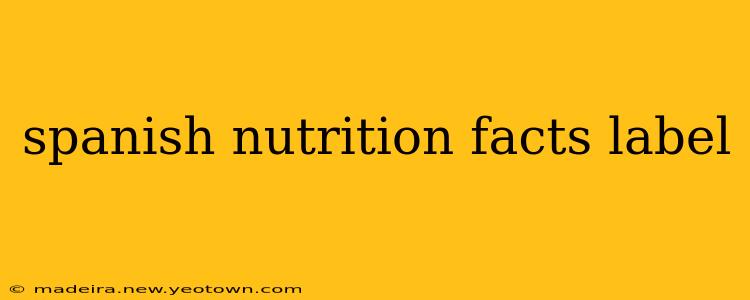Ever stared at a Spanish food label, feeling a bit lost in translation? You're not alone! Navigating the nutritional information on Spanish products can seem daunting, but with a little guidance, it becomes a piece of cake (or maybe a roscón de reyes!). This guide will unravel the mysteries of the Spanish nutrition facts label, turning you into a confident, informed consumer.
Our journey begins with the understanding that while the EU format is generally followed, slight variations may exist depending on the specific product and manufacturer. However, the core elements remain consistent, making this exploration valuable wherever your Spanish culinary adventures may lead.
What are the Key Components of a Spanish Nutrition Facts Label?
The Spanish nutrition facts label, like its counterparts in other EU countries, typically includes the following key components:
-
Declaración de Nutrientes: This translates to "Nutrient Declaration," and it's where the heart of the nutritional information lies.
-
Tamaño de la porción: This means "Serving Size." Understanding the serving size is crucial, as all other values are based on this quantity.
-
Valores por 100 g/ml: This translates to "Values per 100 g/ml" – the nutritional values are often presented both per serving and per 100 grams or milliliters, allowing for easy comparison and calculations.
-
Energía: This is the energy content, usually expressed in kilocalories (kcal) and kilojoules (kJ).
-
Grasas: This refers to fat content, often broken down into:
- Grasas saturadas: Saturated fats.
- Grasas monoinsaturadas: Monounsaturated fats.
- Grasas poliinsaturadas: Polyunsaturated fats. While not always explicitly listed, these are commonly found on more detailed labels.
- Ácidos grasos trans: Trans fats.
-
Hidratos de carbono: This indicates carbohydrate content, further broken down into:
- Azúcares: Sugars.
- Almidón: Starch (often implied rather than explicitly listed).
-
Fibra alimentaria: Dietary fiber.
-
Proteínas: Protein content.
-
Sal: Salt content. This is often expressed as sodium (Na) content, requiring a simple conversion to understand the salt amount.
What does %VRN mean on a Spanish food label?
This is a crucial aspect often confusing to newcomers. %VRN stands for "% Valores de Referencia de Nutrientes," or "% Nutrient Reference Values." These values represent the percentage of the recommended daily intake of each nutrient for an average adult, based on EU guidelines. A higher percentage means a larger contribution to your daily needs (or, potentially, a higher intake than is ideal depending on your total daily diet).
How to Understand the "Ingredientes" Section?
The "Ingredientes" section lists all the ingredients in descending order by weight. This means the ingredient listed first is the most abundant in the product. This information is crucial for those with allergies or specific dietary restrictions. Familiarity with common Spanish ingredients is beneficial here.
Are there differences between Spanish and other EU nutrition labels?
While the overall structure adheres to EU regulations, minor variations might exist in the precise terminology or the order of information. However, the core nutritional values remain consistent, ensuring fair comparisons across different products and countries within the EU.
Where can I find more detailed information about Spanish food labeling regulations?
The official website of the Spanish Ministry of Health (Ministerio de Sanidad) is an excellent source for detailed information on food labeling regulations. This resource will offer in-depth explanations and provide up-to-date information on any changes in regulations.
By understanding these key components, you'll be well-equipped to decode the Spanish nutrition facts label, making informed choices that support your health and culinary explorations. ¡Buen provecho!

